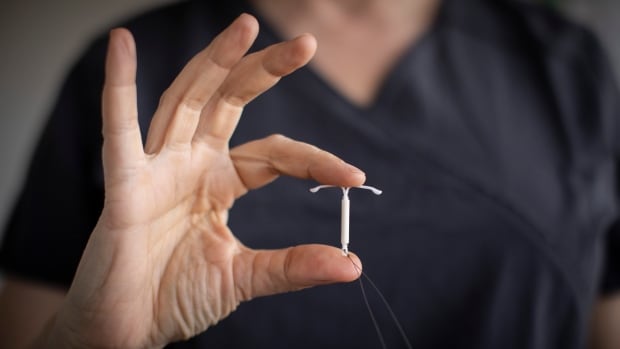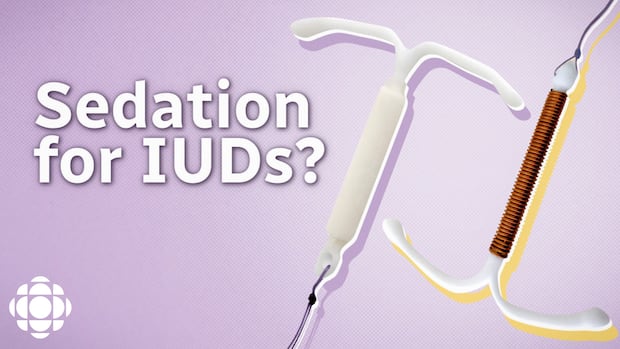The first time Devon Cantwell-Chavez had a long-lasting form of birth control inserted — an intrauterine device, or IUD — it was a smooth, painless experience.
That was in 2018, through her gynecologist in Salt Lake City, Utah. Cantwell-Chavez was provided painkillers, along with a low dose of an anti-anxiety medication with sedative properties.
“It was a very easy experience,” she recalled, “and I honestly don’t remember it.”
A few years later, while pursuing her PhD in Ottawa, the 34-year-old needed to have her three-year IUD swapped out — and was told at a student sexual health clinic that she’d only need over-the-counter painkillers.
Cantwell-Chavez was stunned. She told the clinic’s physician that she passes out during routine pap smears, and fought to get a letter of support from her gynecologist back home in the U.S. to include a sedative, as well. The Ottawa team relented, but she said there was still a lot more pain with that procedure, with the clinic’s on-site doctor later saying she was likely “making up the pain in her head.”
“It seems, more often than not, that’s the response people get in Canada,” she said. “It’s frustrating that we continue to have paltry pain management options.”
The cross-border debate over how to best handle IUD insertions is heating up this week, after the U.S. Centers for Disease Control and Prevention (CDC) released sweeping new guidance on pain management.
Now, for the first time, the CDC is encouraging health-care providers to counsel patients on their options for the typically quick but potentially painful procedure, which inserts a tiny T-shaped device through the vagina and cervix and into the uterus to provide years of highly effective contraception.
Pain experience ‘individualized,’ say new U.S. guidelines
Published on Thursday, the guidelines note that a growing body of evidence suggests lidocaine — either administered as an injection, or a topical cream, gel, or spray — may be useful for reducing pain. Not all trials reached the same conclusions, however, with some studies suggesting there were no reductions in pain following use of that local anesthetic.
Misoprostol, meanwhile, is “not recommended for routine use” for IUD placement.
The CDC said evidence does suggest the cervix-softening drug, which is also used to induce labour, may help with pain relief in certain circumstances, such as for patients with a recent failed placement of their IUD.
“When considering patient pain, it is important to recognize that the experience of pain is individualized and might be influenced by previous experiences including trauma and mental health conditions, such as depression or anxiety,” the guidelines state.
Canadian guidance outlines various forms of pain management
It’s a marked shift from the CDC’s last country-wide recommendations close to a decade ago, and a stark contrast to advice often provided to patients in Canada — which is to simply take over-the-counter pain medications prior to the IUD insertion procedure.
An IUD information page provided by health officials in Alberta, for instance, suggests patients take acetaminophen (Tylenol), ibuprofen (Advil, Motrin), or naproxen (Aleve) if needed.
Similar guidance is provided in B.C., with a government page noting patients “may be asked to take a pain medicine such as ibuprofen (Advil or Motrin)” 30 to 60 minutes before the procedure to help with cramps during the IUD placement.
So what’s the guidance at the federal level?
Health Canada said in a statement that while it regulates medical devices, “the department does not provide medical advice on the use of these products,” adding provincial and territorial health authorities are better positioned to discuss guidelines.
There is broad guidance from the Society of Obstetricians and Gynecologists in Canada (SOGC) — last updated in December 2022 — which does note other ways to manage pain, ranging from oral drugs like naproxen and tramadol, to lidocaine creams, sprays and injections.
Low-dose methoxyflurane, an inhaled painkiller, may also be suitable, the SOGC says, though there’s no data linking it to effective pain relief during IUD insertions.
“It is important that health-care providers counsel patients about what can be expected during the IUD placement process, including pain control options,” that guidance continues.
Getting an IUD can sometimes hurt, bad. A few Planned Parenthood clinics in the U.S. are now offering sedation during intrauterine device (IUD) procedures. So why isn’t sedation widely available in Canada?
But multiple IUD users told CBC News the advice doesn’t always translate into health-care providers actually offering broader ways to tackle potential pain.
Maggie Archibald, a 29-year-old Halifax resident, has had two rounds of IUD insertions in hopes of managing heavy periods and pelvic pain caused by her endometriosis. The first time, in 2020, she had the procedure at a sexual health clinic, and was just told to take Tylenol or Advil beforehand.
Archibald rated her pain level during the procedure at a seven out of 10.
“I would consider myself someone very tolerable to pain, but that experience was quite uncomfortable,” she told CBC News. “The pain, for me, lasted less than 30 seconds, but then came the cramping afterward.”
More recently, when she had a newer type of IUD inserted at a hospital, Archibald said she was given both an anti-anxiety medication and painkillers in advance.
“That whole second experience was quite better,” she said. “I don’t really remember anything in terms of pain, or experiencing any discomfort.… They wanted me to be comfortable.”
Childbirth can influence IUD insertion pain
The debate over the best approaches to pain management seems particularly pressing, given the global popularity of IUDs — and the divide between how patients and medical teams view the pain associated with these procedures.
Researchers say the level of pain patients experience is linked to various factors, including anxiety levels, overall pain tolerance and fear of pain itself.
Most acute may be the timing of an insertion either before or after someone has given birth, some studies suggest. One paper found that when women had not previously given birth, the IUD insertion pain they experienced was “significantly higher” compared to women who’d had a previous vaginal delivery.
Analysis by the Canadian Paediatric Society shows intra-uterine devices are more effective than the pill in preventing pregnancy.
38-year-old Amy Hall-Cummings, a Beamsville, Ont., resident, said the pain she experienced from IUD insertions before and after the birth of her son was “night and day.”
Hall-Cummings’s first IUD was inserted at her family doctor’s office in 2014, and she said there were no conversations about pain management beforehand.
“There was no prescription given. Some people I know have had a cervical dilator, I did not get that. I wasn’t even told to take some Tylenol.”
Despite being told to expect a “little pinch” while having her cervix clamped open for the insertion, she said the procedure was incredibly painful. Yet her second round, not long after her son’s birth in 2020, was far less uncomfortable.
8 in 10 women rate pain as moderate or severe: study
Overall, roughly eight in 10 women feel insertion pain is either moderate or severe, according to a study from the British Medical Journal.
Meanwhile other U.S. research looking at the experiences of around 200 women, most of whom had previously given birth, scored the maximum pain level during the procedure at nearly 65 out of 100 — yet health-care providers rated their patients’ pain at about 35.
And while awareness of pain management options and perceptions may be growing, the possibilities for making the procedure less painful aren’t exactly new.
An article for a University of British Columbia faculty of medicine series dubbed “This Changed My Practice” — which was published nearly a decade ago — outlined one physician’s shift toward providing more pain management for IUD insertions.
“After I caused excruciating pain to a [young women who hadn’t previously given birth], I made a conscious decision to take all the steps that I could to minimize the pain of insertion,” wrote the author, since-retired B.C. obstetrician-gynecologist Dr. Roberto Leon, back in 2016.
Leon’s later approach involved a full presentation to his patients on how to minimize pain, along with offering painkillers, anti-anxiety medications, and lidocaine injections.
His final conclusion?
Using all possible pain management tools can reduce people’s discomfort during the often-feared procedure, Leon wrote, “to the delight of our patients.”




